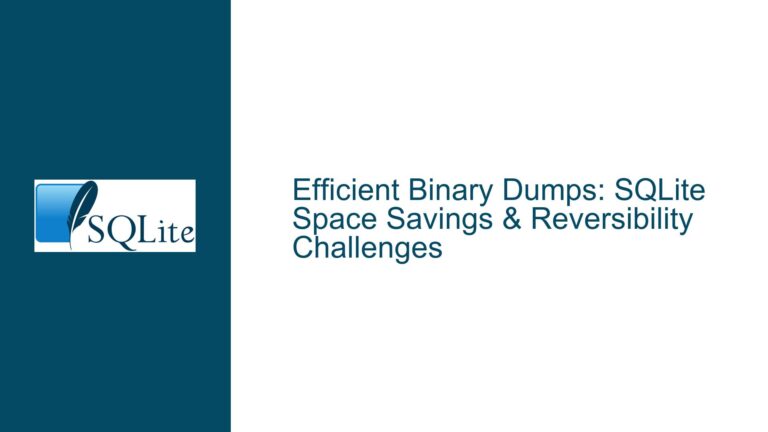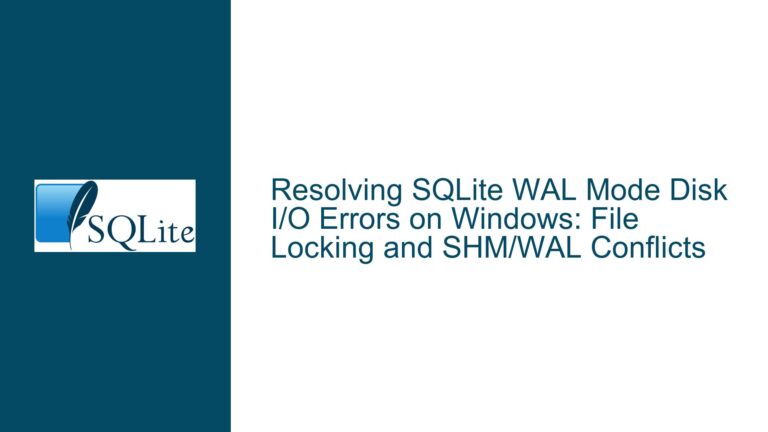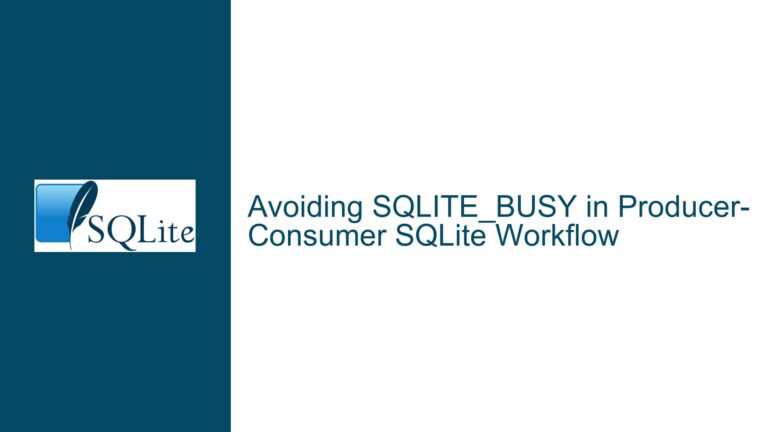Optimizing SQLite for Temporary Token Storage with 10-Minute Expiry
Storing and Managing Tokens with a 10-Minute Expiry Window
When dealing with temporary data such as tokens that are valid for only 10 minutes, SQLite can be an excellent choice due to its lightweight nature and ease of use. However, managing such transient data efficiently requires careful consideration of schema design, query optimization, and database maintenance. The core challenge lies in ensuring that the database does not grow indefinitely while maintaining the ability to quickly insert, query, and delete records. Below, we will explore the nuances of this problem, identify potential pitfalls, and provide detailed solutions to optimize SQLite for this use case.
Understanding the Token Expiry Mechanism and Its Impact on Database Growth
The primary requirement is to store tokens that are valid for only 10 minutes and ensure that once a token is used, it cannot be reused within its validity window. To achieve this, each token is written to a table along with a timestamp indicating when it was created. A cleanup process runs every 10 minutes to delete records older than the validity period. While this approach seems straightforward, it raises several questions about SQLite’s behavior and potential optimizations.
One of the key concerns is whether SQLite will reuse the memory left over from deleted records or if manual intervention, such as running the VACUUM command, is required to reclaim space. Additionally, the strategy of deleting records in bulk every 10 minutes may lead to inefficiencies, especially if the table grows significantly during peak loads. For instance, if a million tokens are used within a 10-minute window, the table must accommodate all these records before the cleanup process removes them. This cyclical growth and contraction can impact performance and storage efficiency.
Another consideration is the accuracy of the cleanup process. The current implementation may retain some records for up to 20 minutes, depending on the timing of the cleanup job. This discrepancy arises because the cleanup process runs at fixed intervals, and records created just before the cleanup job executes may not be deleted until the next cycle. This behavior deviates from the stated goal of retaining records for only 10 minutes.
To address these challenges, we need to delve deeper into SQLite’s internal mechanisms and explore alternative strategies for managing temporary data. By understanding how SQLite handles deleted records and how to optimize schema design and queries, we can create a more efficient and scalable solution.
Potential Causes of Inefficiency in Token Storage and Cleanup
Several factors contribute to the inefficiencies in the current implementation of token storage and cleanup. These include the timing of the cleanup process, the lack of indexing on timestamps, and the absence of a mechanism to reuse expired rows. Let’s examine each of these factors in detail.
1. Timing of the Cleanup Process
The cleanup process runs every 10 minutes to delete records older than the validity period. However, this fixed interval can lead to inconsistencies in record retention. For example, a token created just before the cleanup job runs may remain in the table for nearly 20 minutes before being deleted. This behavior violates the requirement that tokens should be retained for no more than 10 minutes. To address this issue, the cleanup process must be more precise, either by running more frequently or by using a more sophisticated mechanism to identify and delete expired records.
2. Lack of Indexing on Timestamps
The current implementation does not specify whether the timestamp column is indexed. Without an index, queries to identify expired records can become slow, especially as the table grows. For instance, a query to find all records older than 10 minutes would require a full table scan, which is inefficient for large datasets. Adding an index on the timestamp column can significantly improve query performance, but it comes at the cost of increased storage space and slightly slower write operations.
3. Absence of Row Reuse Mechanism
When a token expires, its corresponding row in the table is deleted. However, SQLite does not immediately reclaim the space occupied by deleted rows. Instead, the space is marked as free and can be reused for future inserts. While this behavior is generally efficient, it does not prevent the database file from growing over time. Running the VACUUM command can reclaim this space, but it is a heavyweight operation that may not be suitable for frequent execution. An alternative approach is to reuse expired rows for new tokens, thereby minimizing the need for new inserts and reducing database growth.
4. Unoptimized Schema Design
The current schema stores only the token and its creation timestamp. While this design is simple, it may not be optimal for the use case. For example, storing both the creation and expiry timestamps can simplify queries and improve performance. Additionally, using a composite primary key or unique constraint on the token can prevent duplicates and ensure data integrity. These optimizations require careful consideration of the trade-offs between storage efficiency, query performance, and implementation complexity.
Detailed Troubleshooting Steps, Solutions, and Fixes for Efficient Token Management
To address the issues outlined above, we can implement a series of optimizations and best practices. These include refining the cleanup process, optimizing schema design, leveraging indexing, and reusing expired rows. Below, we will explore each of these solutions in detail.
1. Refining the Cleanup Process
To ensure that tokens are retained for no more than 10 minutes, the cleanup process must be more precise. One approach is to run the cleanup job more frequently, such as every minute, and delete records that are older than 10 minutes at the time of execution. This reduces the maximum retention time to 11 minutes, which is closer to the desired 10-minute window.
Alternatively, we can use a trigger-based approach to delete expired records immediately after they are no longer valid. For example, a trigger can be created to delete records as soon as their timestamp exceeds the 10-minute threshold. This approach eliminates the need for a separate cleanup job and ensures that records are deleted promptly.
2. Optimizing Schema Design
The schema can be optimized to store both the creation and expiry timestamps for each token. This allows queries to filter expired records more efficiently and simplifies the cleanup process. For example, a query to find expired records can use the expiry timestamp instead of calculating it from the creation timestamp. Additionally, the schema can include a unique constraint on the token to prevent duplicates and ensure data integrity.
Here is an example of an optimized schema:
CREATE TABLE tokens (
token TEXT PRIMARY KEY,
creation_timestamp INTEGER NOT NULL,
expiry_timestamp INTEGER NOT NULL
);
CREATE INDEX idx_tokens_expiry ON tokens (expiry_timestamp);
3. Leveraging Indexing
Adding an index on the expiry timestamp can significantly improve query performance. For example, a query to find expired records can use the index to quickly locate the relevant rows. However, indexing comes at the cost of increased storage space and slightly slower write operations. Therefore, it is important to weigh the benefits of indexing against the potential drawbacks.
4. Reusing Expired Rows
To minimize database growth, we can reuse expired rows for new tokens. This approach involves selecting an expired row, updating its contents with the new token and timestamps, and reinserting it into the table. If no expired rows are available, a new row is inserted. This strategy ensures that the table size remains close to the historical peak load, reducing the need for frequent VACUUM operations.
Here is an example of how to implement row reuse:
-- Select an expired row
SELECT token FROM tokens WHERE expiry_timestamp < CURRENT_TIMESTAMP LIMIT 1;
-- If an expired row is found, update it with the new token and timestamps
UPDATE tokens
SET token = ?, creation_timestamp = ?, expiry_timestamp = ?
WHERE token = ?;
-- If no expired row is found, insert a new row
INSERT INTO tokens (token, creation_timestamp, expiry_timestamp)
VALUES (?, ?, ?);
5. Monitoring and Maintenance
Regular monitoring and maintenance are essential to ensure the long-term efficiency of the database. This includes periodically running the VACUUM command to reclaim space, analyzing query performance, and adjusting schema design as needed. Additionally, logging and alerting can be implemented to detect and address issues such as unexpected table growth or slow queries.
By implementing these optimizations and best practices, we can create a robust and efficient solution for managing temporary tokens in SQLite. This approach balances performance, storage efficiency, and implementation complexity, ensuring that the database meets the requirements of the use case while remaining scalable and maintainable.






